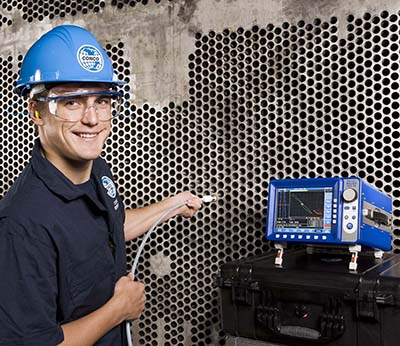Eddy current inspection

Based on the principle of electromagnetic induction, a method to detect the surface defects of metal materials by eddy current induction on the surface of metal components.
Inspection method
Eddy current inspection is use conductor to close to alternating current coil, established alternating magnetic field by coils, the alternating magnetic field through the conductor, and the occurrence of electromagnetic induction and the eddy current was established in conductor. Eddy current of conductor will produce its own magnetic field, eddy current magnetic field changes the original magnetic field intensity, which led to the change of the coil voltage and impedance. When the conductor surface or near surface has defects, will affect the intensity and distribution of eddy current, eddy current lead to change of voltage and impedance of detection coil , according to this change, we can indirectly know the existence of defects in the conductor.
Due to the different shape of metal products, the different of detection position, So need different forms of coil test coil. In order to meet the needs of various testing, our company has a variety of detection coil as follows.
-Feed-through coil
The through coil is a coil which is detected in the coil, suitable for tube, rod, wire inspection,The magnetic field produced by the coil acts on the outer wall of metal products,therefore, it is better to detect the surface defects.
-Inserted coil
The inserted coil is a coil which is placed inside the tube, which is used to inspect the defects of the thick wall or the inner wall of the borehole. It is also used to check the quality of the pipe in the complete set of equipment, such as the inspection of the heat exchanger tube.
-Probe coil
The probe coil is placed on the surface of metal products, it is not only suitable for the surface flaw inspect of simple shape of the plate, slab, billet, round billet, bar and large diameter pipe, but also for inspection of mechanical parts with complex shapes. compared with the Feed-through coil, the probe coil’s volume smaller, so suitable for the detection of surface defects of small size.
